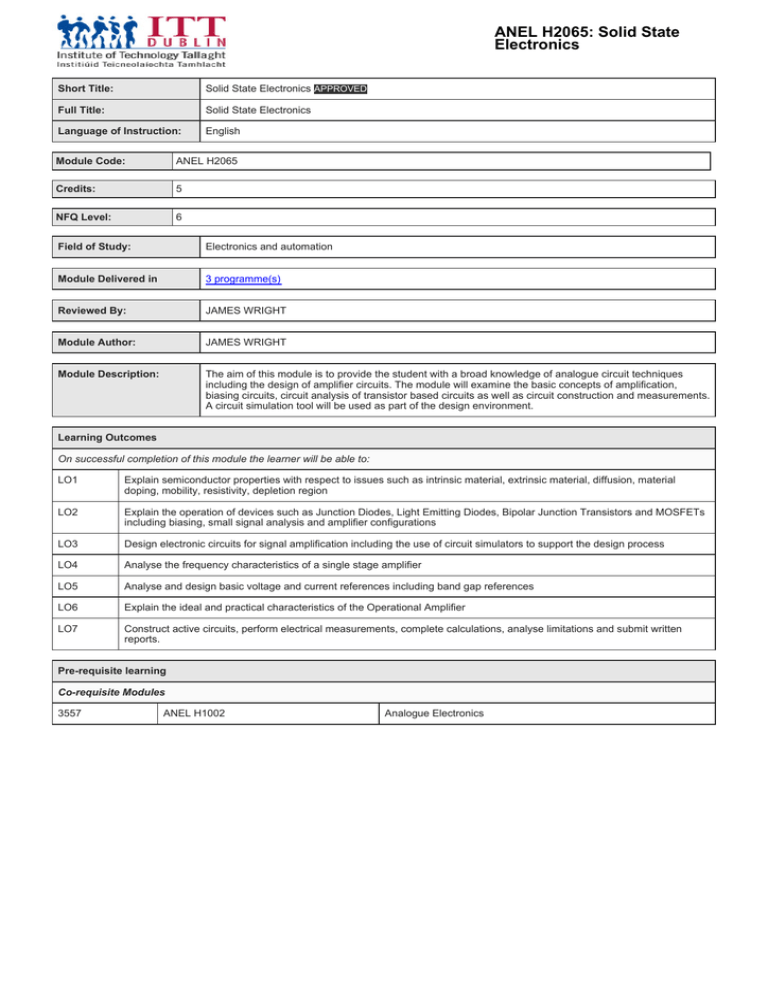
ANEL H2065: Solid State
Electronics
Short Title:
Solid State Electronics APPROVED
Full Title:
Solid State Electronics
Language of Instruction:
English
Module Code:
ANEL H2065
Credits:
5
NFQ Level:
6
Field of Study:
Electronics and automation
Module Delivered in
3 programme(s)
Reviewed By:
JAMES WRIGHT
Module Author:
JAMES WRIGHT
Module Description:
The aim of this module is to provide the student with a broad knowledge of analogue circuit techniques
including the design of amplifier circuits. The module will examine the basic concepts of amplification,
biasing circuits, circuit analysis of transistor based circuits as well as circuit construction and measurements.
A circuit simulation tool will be used as part of the design environment.
Learning Outcomes
On successful completion of this module the learner will be able to:
LO1
Explain semiconductor properties with respect to issues such as intrinsic material, extrinsic material, diffusion, material
doping, mobility, resistivity, depletion region
LO2
Explain the operation of devices such as Junction Diodes, Light Emitting Diodes, Bipolar Junction Transistors and MOSFETs
including biasing, small signal analysis and amplifier configurations
LO3
Design electronic circuits for signal amplification including the use of circuit simulators to support the design process
LO4
Analyse the frequency characteristics of a single stage amplifier
LO5
Analyse and design basic voltage and current references including band gap references
LO6
Explain the ideal and practical characteristics of the Operational Amplifier
LO7
Construct active circuits, perform electrical measurements, complete calculations, analyse limitations and submit written
reports.
Pre-requisite learning
Co-requisite Modules
3557
ANEL H1002
Analogue Electronics
ANEL H2065: Solid State
Electronics
Module Content & Assessment
Content (The percentage workload breakdown is inidcative and subject to change)
%
Semiconductors :
Energy bands of metals, semiconductors and insulators. Intrinsic and extrinsic semiconductors. p-type and n-type
semiconductors. Charge carriers. Conductivity of semiconductors
12.00%
The Bipolar Transistor
Structure and operation. Common-base and common emitter configuration.Transistor gain calculations; bias conditions. Thermal
runaway
26.00%
The MOSFET.
Operation and structure of the MOSFET in depletion and enhancement modes. I-V characteristics of the MOSFET. Biasing
circuits and amplifier circuits.
20.00%
Operation Amplifiers and Applications
Op-amp applications and effects of limitations such as input bias current, input offset current, input offset voltage, gain-bandwidth
product and slew rate.
17.00%
Amplifier Design
Basic analysis and design of BJT and MOSFET amplifier circuits. Frequency response of amplifiers, feedback techniques,
stability of amplifiers. Using CAD Tools to design the amplifer circuit
25.00%
Assessment Breakdown
%
Course Work
40.00%
End of Module Formal Examination
60.00%
Course Work
Assessment Type
Assessment Description
Outcome
addressed
% of
total
Assessment
Date
Continuous
Assessment
Weekly Laboratory Sessions involving Circuit Construction, circuit
analyse, and report writing
2,3,4,5,7
15.00
Ongoing
Practical/Skills
Evaluation
Practical Laboratory Test
2,4,5,7
5.00
Week 4
Continuous
Assessment
Mid-Term Assessment
1,2,3,4,5
10.00
Week 6
Practical/Skills
Evaluation
Practical Laboratory Test relating to circuit construction to this
point
2,4,5,7
10.00
Week 11
End of Module Formal Examination
Assessment Type
Assessment Description
Outcome
addressed
% of
total
Assessment Date
Formal Exam
End-of-Semester Final Examination
1,2,3,4,5,7
60.00
End-of-Semester
Reassessment Requirement
Repeat examination
Reassessment of this module will consist of a repeat examination. It is possible that there will also be a requirement to be reassessed in a
coursework element.
Reassessment Description
The student may be required to take laboratory sessions which have been missed during the first sitting of the module
IT Tallaght reserves the right to alter the nature and timings of assessment
ANEL H2065: Solid State
Electronics
Module Workload
Workload: Full Time
Workload Type
Workload Description
Hours
Frequency
Average
Weekly
Learner
Workload
Lecture
Classroom work
2.00
Every
Week
2.00
Laboratories
Directed practical laboratory session
2.00
Every
Week
2.00
Independent Learning
Work conducted outside of classroom involving reporting,
assignments and problems
3.00
Every
Week
3.00
Total Weekly Learner Workload
7.00
Total Weekly Contact Hours
4.00
Workload: Part Time
Workload Type
Workload Description
Hours
Frequency
Average
Weekly
Learner
Workload
Lecture
Classroom work
2.00
Every
Week
2.00
Laboratories
Directed Practical laboratory work
2.00
Every
Second
Week
1.00
Independent Learning
Work conducted outside of classroom involving reporting,
assignments and problems
4.00
Every
Week
4.00
Total Weekly Learner Workload
7.00
Total Weekly Contact Hours
3.00
Module Resources
Required Book Resources
Thomas L. Floyd 2006, Electronics fundamentals, Pearson Prentice Hall Upper Saddle River, N.J. [ISBN: 978-0131995857]
Streetman, Ben ; Banerjee, Sanjay 2010, Solid State Electronic Devices, Sixth Ed., Prentice Hall USA [ISBN: 978-0-13-245479-7]
David A. Bell 2008, Fundamentals of electronic devices and circuits, 5th Ed., Canada [ISBN: 9780195425239]
Theodore F. Bogart, Jeffrey S. Beasley, Guillermo Rico 2001, Electronic devices and circuits, Prentice Hall Upper Saddle River,
N.J. [ISBN: 978-0130851789]
This module does not have any article/paper resources
This module does not have any other resources
Module Delivered in
Programme Code
Programme
Semester
Delivery
TA_EAELE_B
Bachelor Degree in Engineering (Honours) in Electronic Engineering
4
Mandatory
TA_EAELE_D
Bachelor of Engineering in Electronic Engineering
3
Mandatory
TA_EELEC_C
Higher Certificate in Engineering in Electronic Engineering
3
Mandatory

